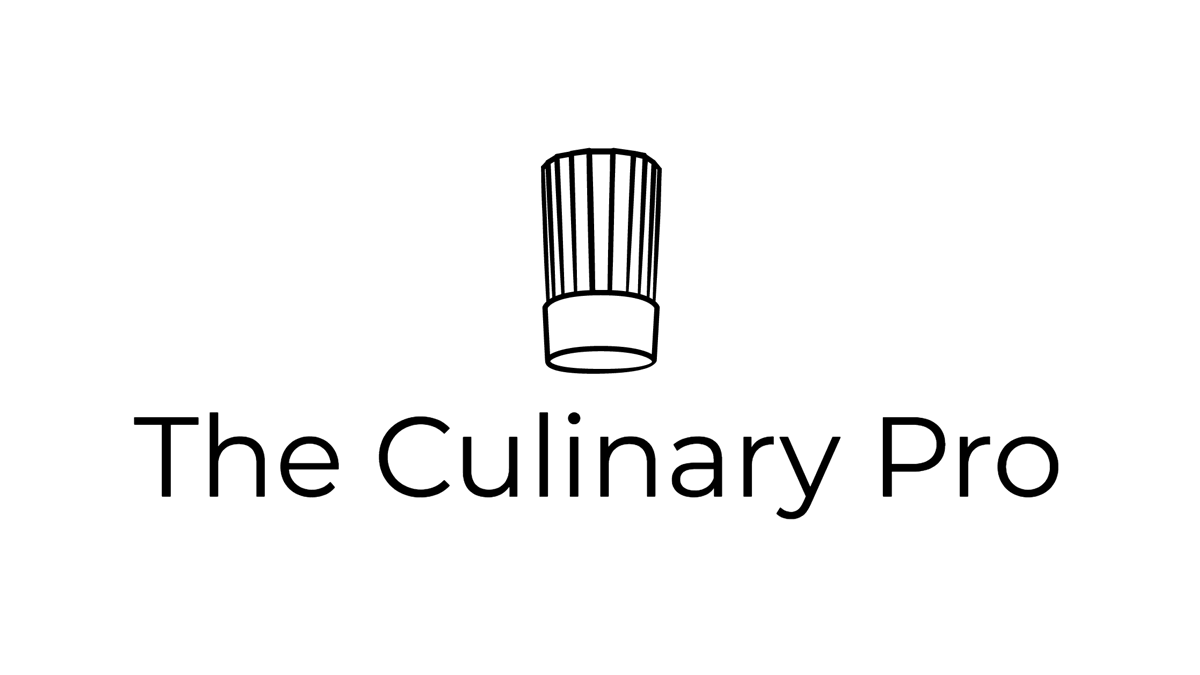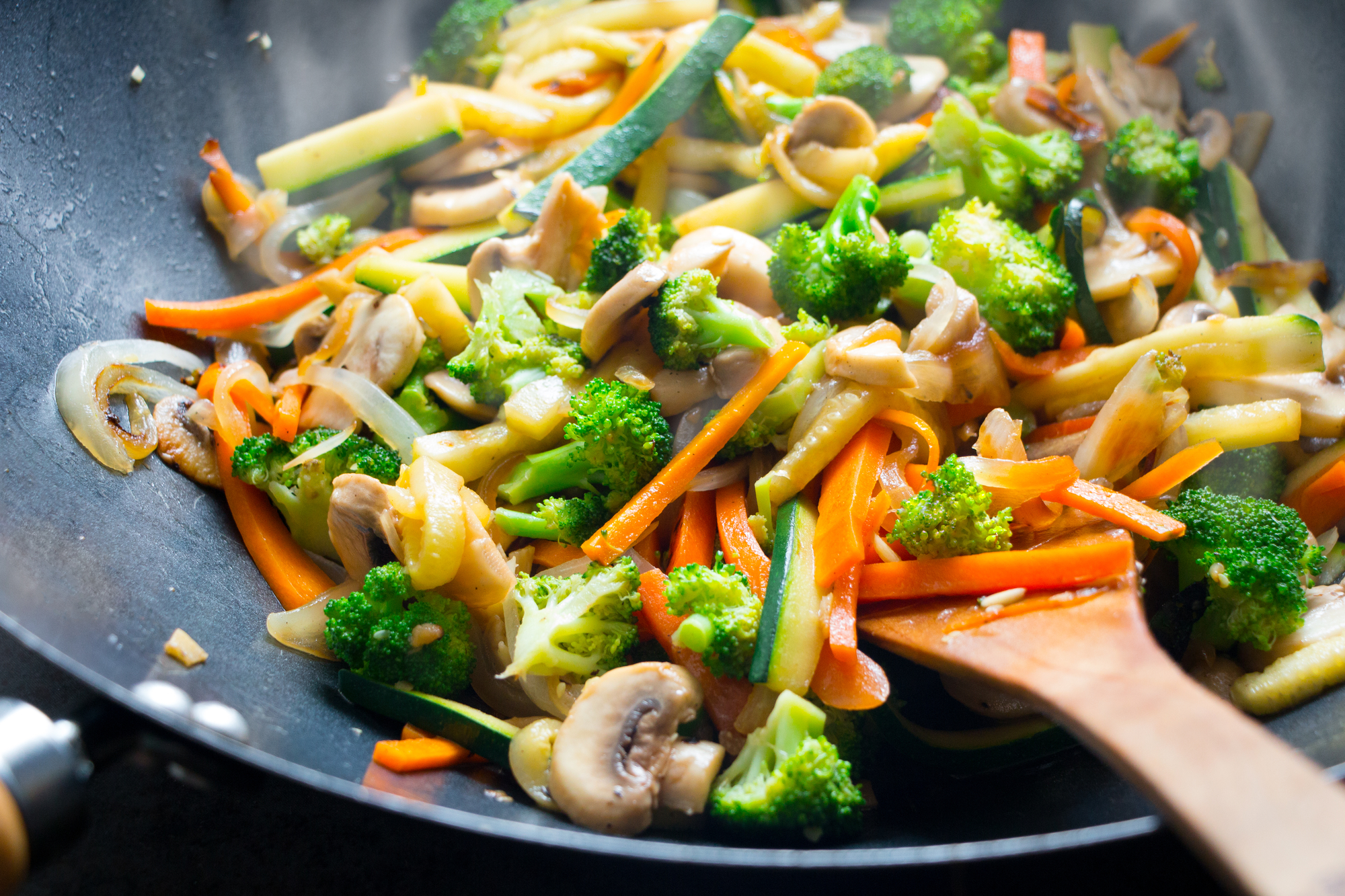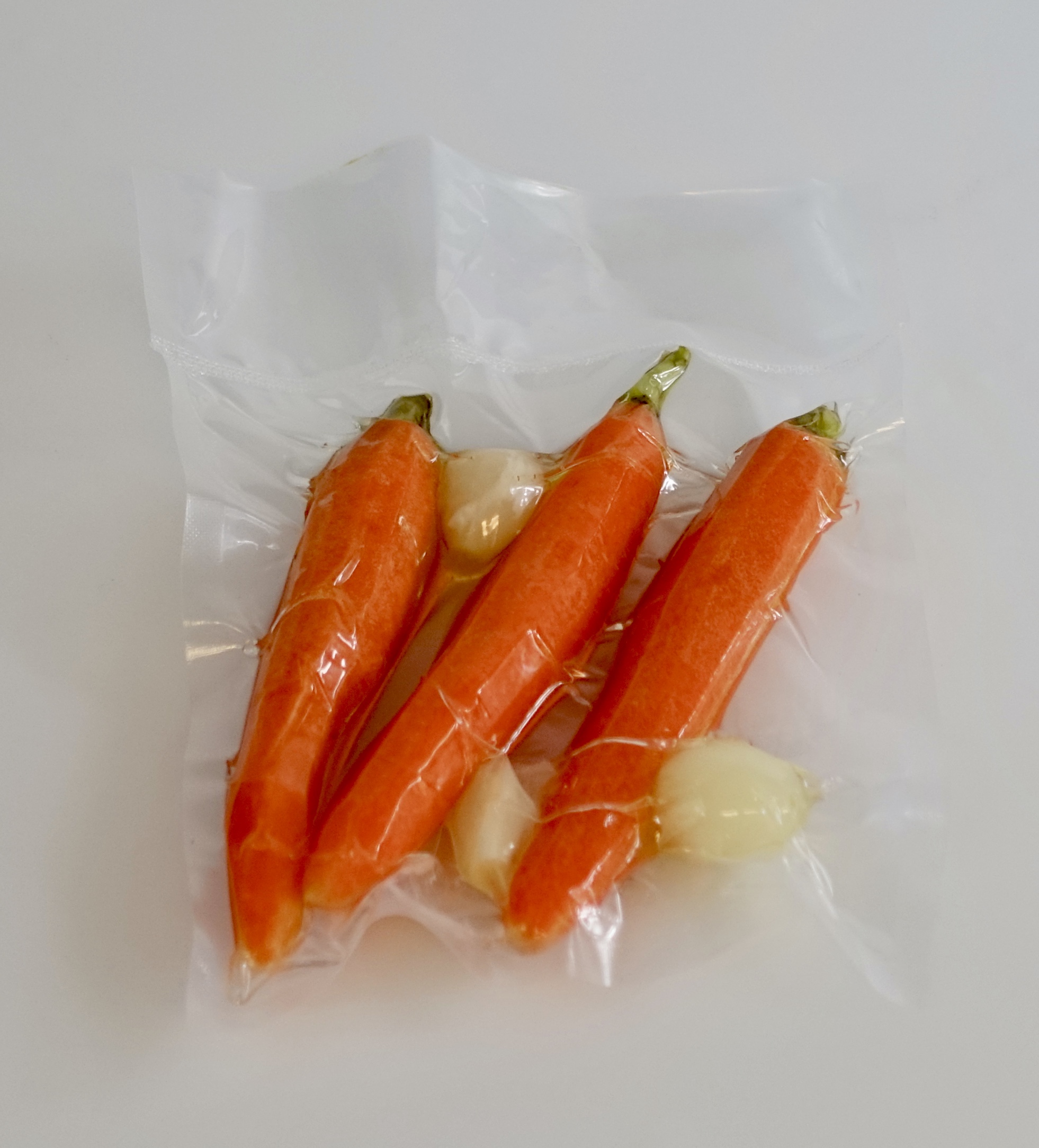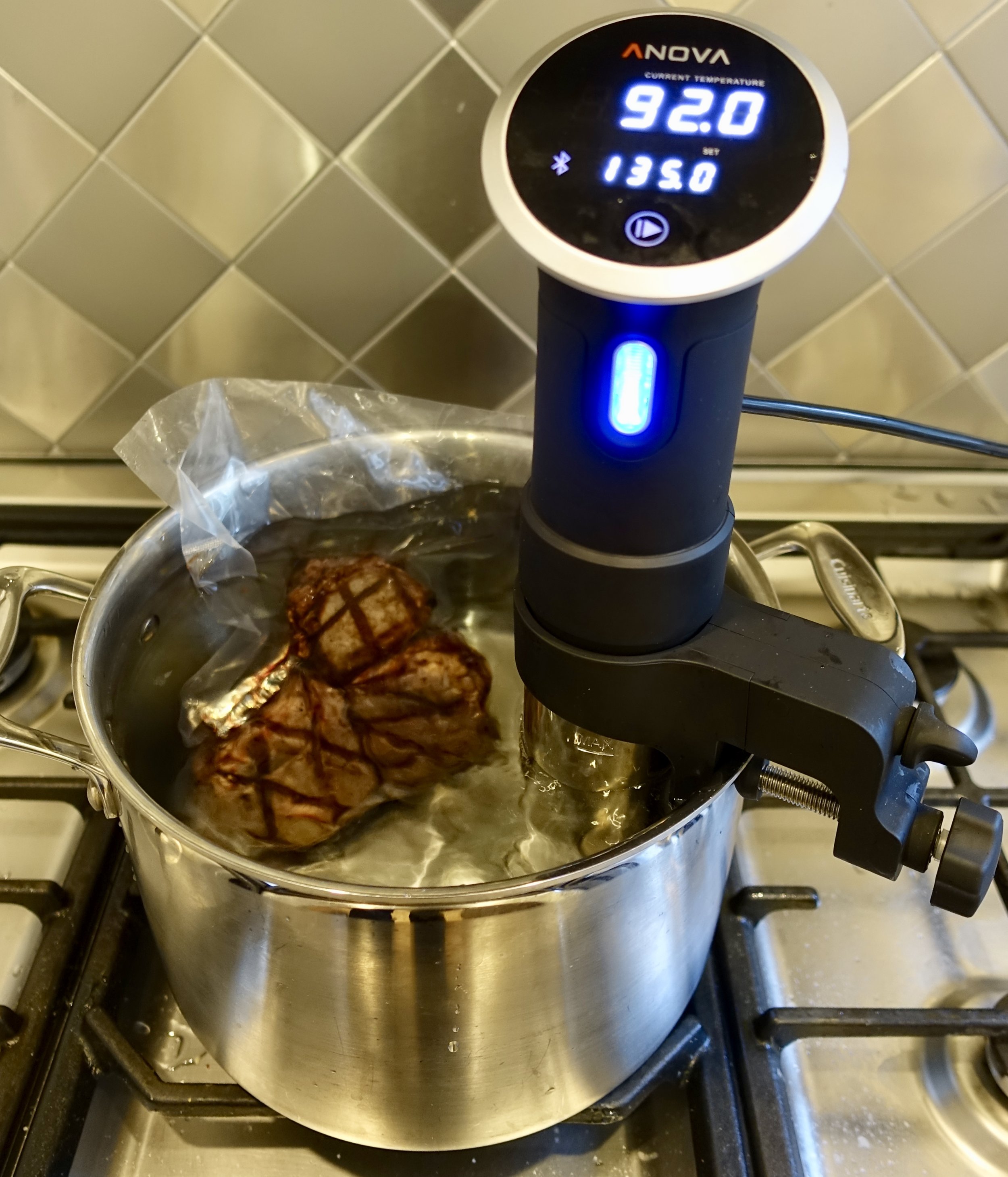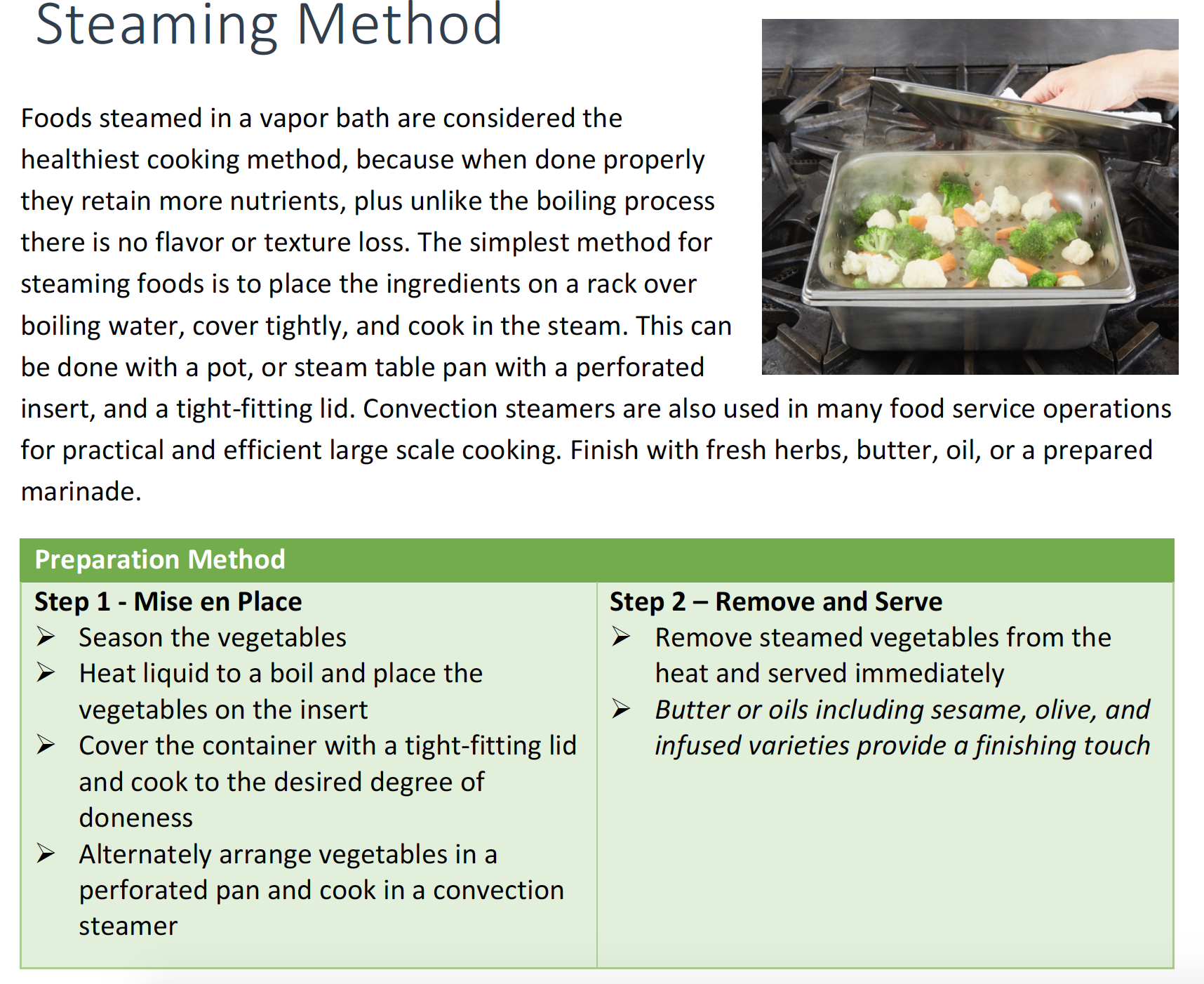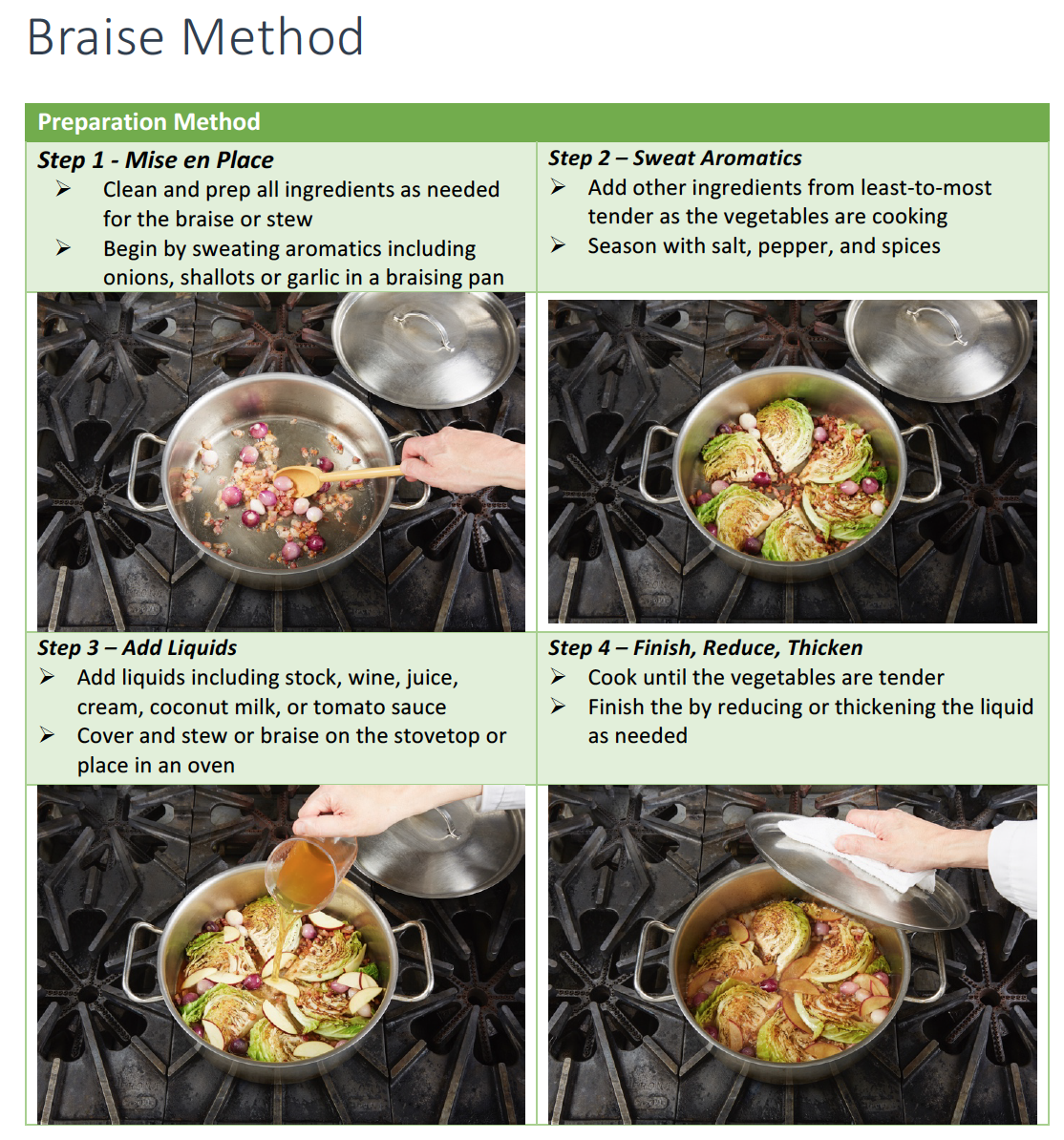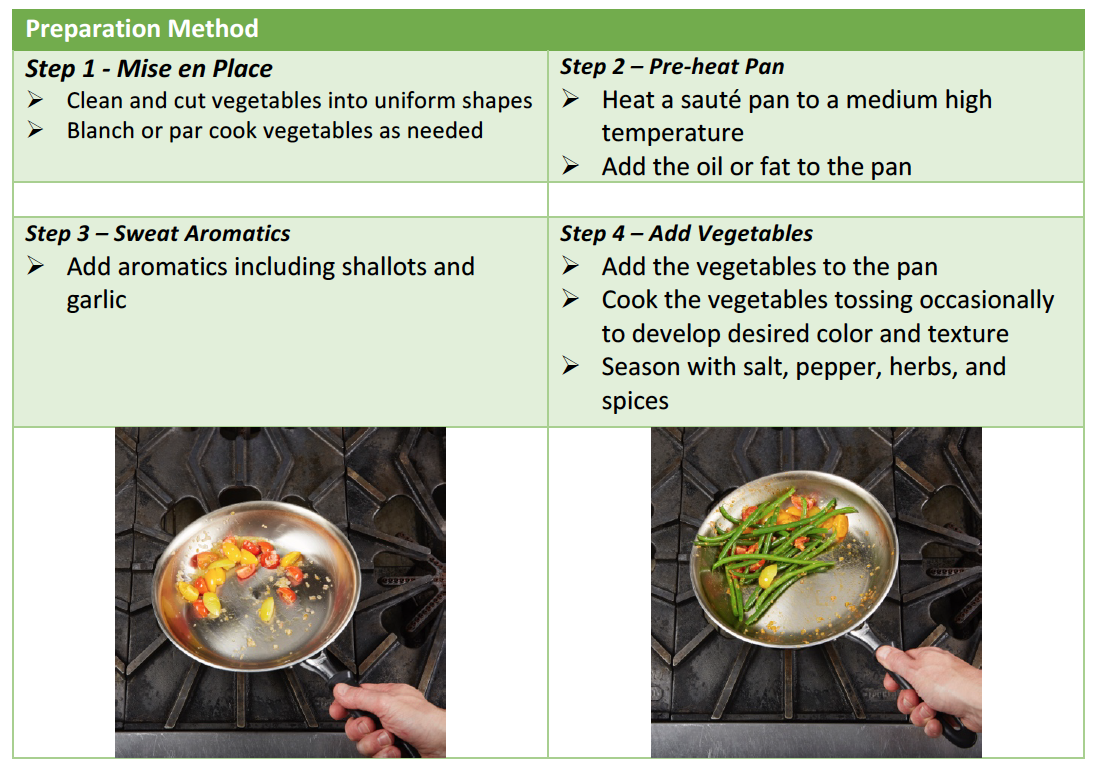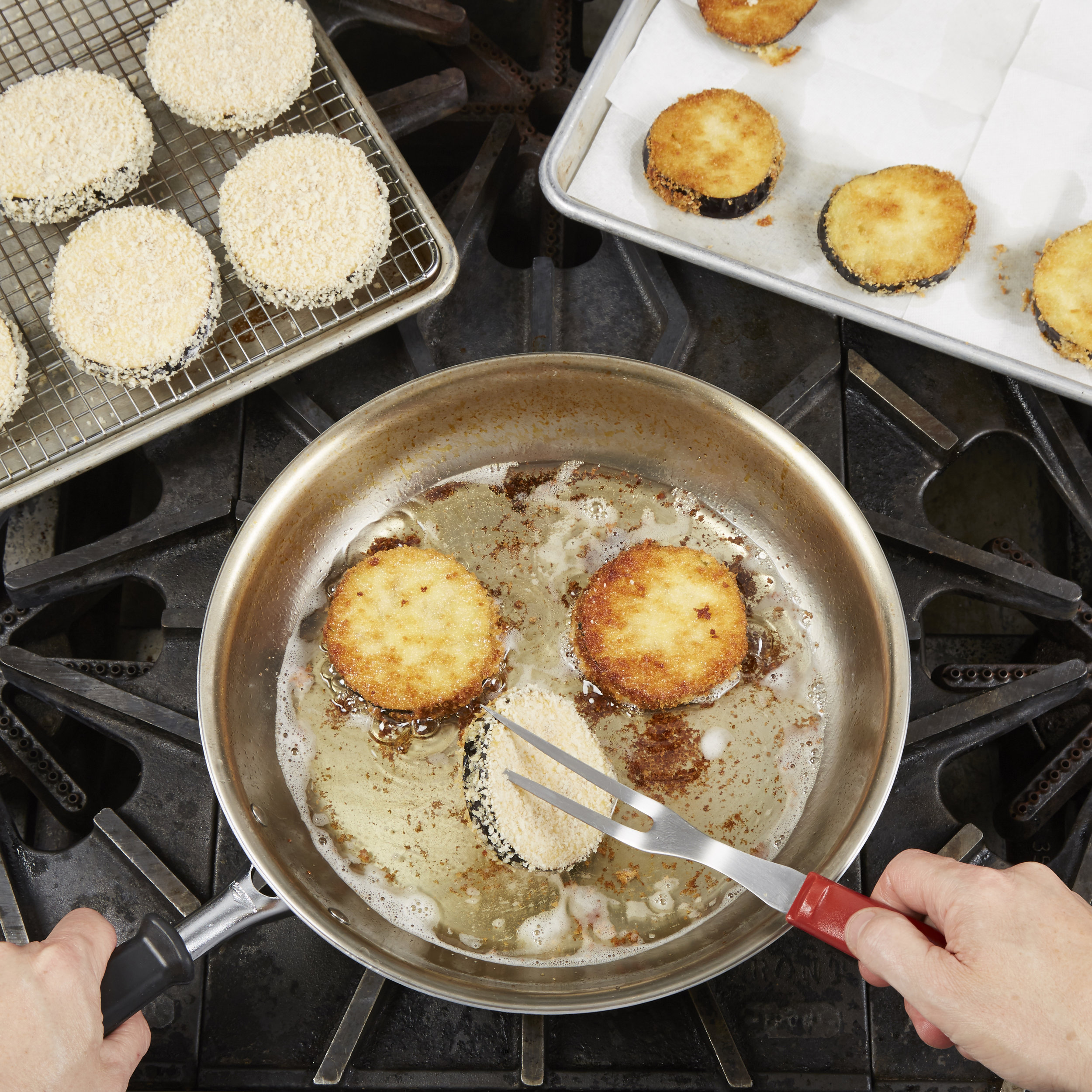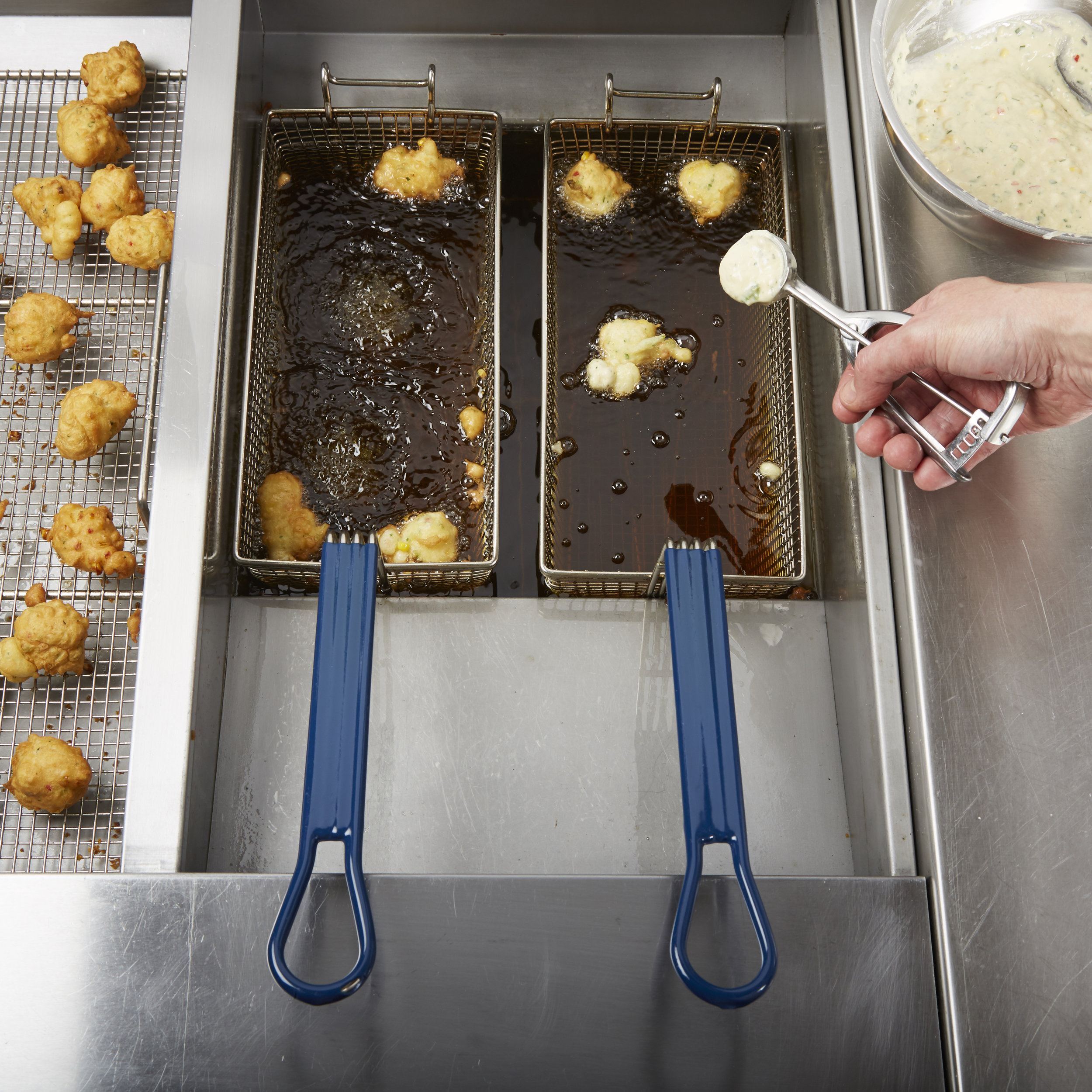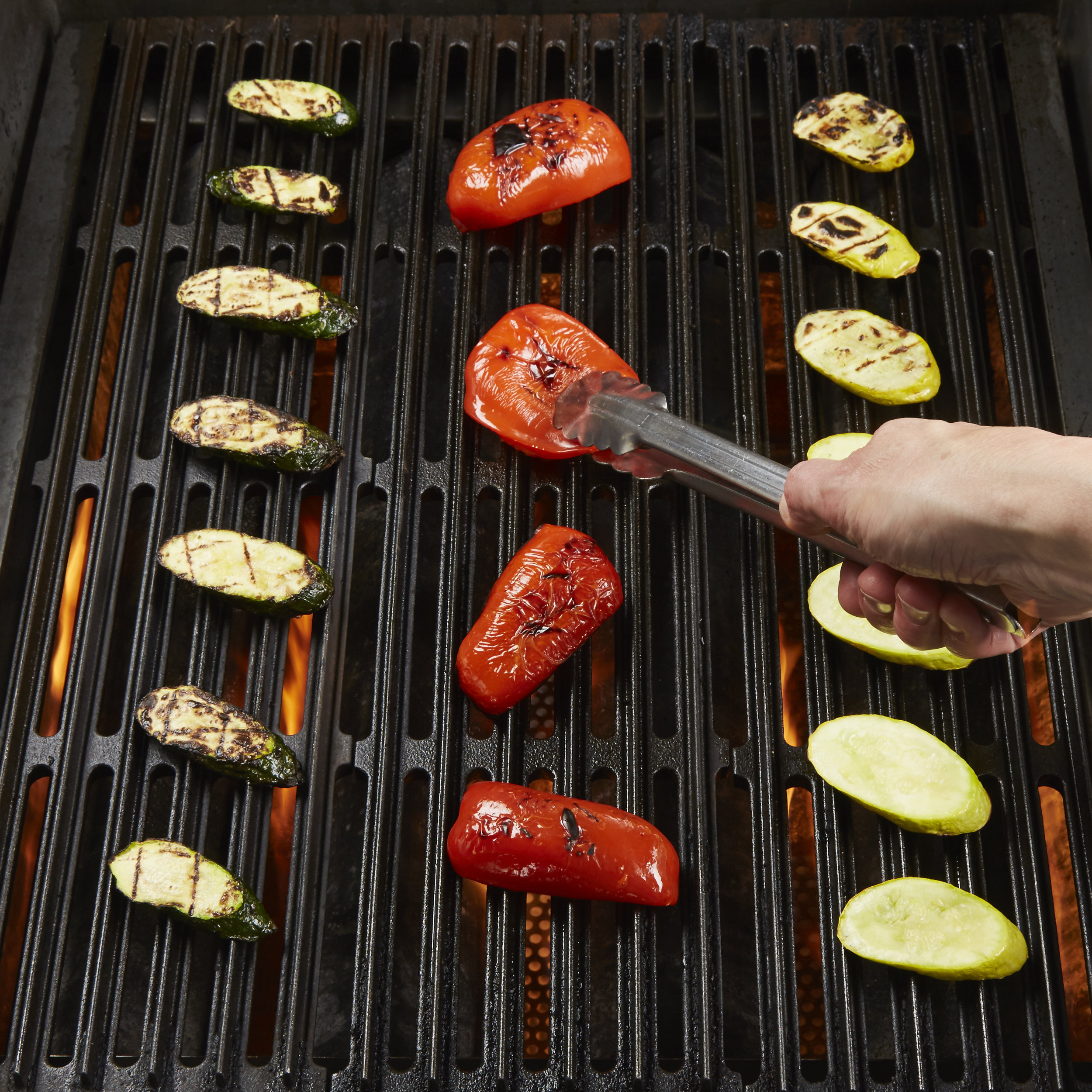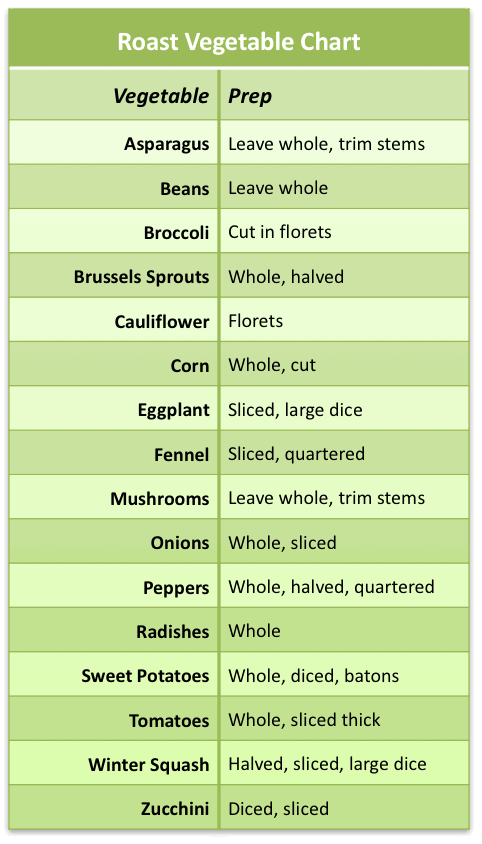Vegetable Cookery
As consumers demand healthier menu options, professional kitchens today are incorporating more vegetables into their menus. The popularity of locally grown and organic foods and the rise of vegetarian and Mediterranean diets has put vegetables in demand. However, vegetables are delicate and deteriorate rapidly, so they must be handled with extra care to maintain their integrity.
Vegetables are cooked to develop color, texture, and flavor. Because of the wide varieties, cooking methods vary depending on the desired result. In professional foodservice production, vegetables are often blanched or par-cooked in boiling salted water as a mise en place step and finished by other cooking methods such as sautéing, frying, or roasting.
Equally important in this process is the added step of shocking the vegetables in an ice water bath, which brightens and sets the color making them more visually appealing. Some vegetables, like roots or dried legumes, need prolonged cooking to tenderize and make them digestible, while others, like tender leafy greens, may only need a few seconds to help set their color. Deep-frying, grilling, braising, and roasting develop distinct textures, colors, and flavors through caramelization or adding flavorful liquids.
Cooking Vegetables
Cooking activates flavor molecules and provides significant textural changes to vegetables.
Use optimal cooking methods and techniques to preserve color, flavor, texture, and nutrients.
Overcooking can create bitter or unpleasant flavors to develop in vegetables from the cabbage family; avoid overcooking.
Vegetables in the onion family mellow and sweeten when cooked
Terminology
Standard culinary terms used in cooking vegetables include boiling, deep-frying, roasting, or grilling. Here are a few that are often used in vegetable preparation.
Blanch – To briefly cook for from 30 seconds up to two minutes. This method is used for tomato concassé or stone fruits like peaches to loosen the skin for peeling. It is also used for tender leafy greens and herbs (spinach or basil.)
Par Boil/Par Cook – Partially cook longer than the blanching process. This may mean cooking the ingredient halfway or more for finishing on the service line. This method applies to vegetables, pasta, rice, and other grains.
Al Dente – An Italian term meaning “to the tooth,” used to describe pasta that is tender but firm to the bite. This term describes the correct degree of doneness for vegetables, grains, and other foods.
Moist Heat Cooking Methods
Boil/A l’anglaise
The French term “a l’anglaise” refers to cooking foods in water or other liquids. Chef Thomas Keller of the French Laundry and Per Se restaurants calls this “Big Pot Blanching.” It is a mise en place method commonly used in professional kitchens when prepping quantities of vegetables for service.
Most any vegetable can be blanched, par-cooked, or fully cooked in this fashion. First, the vegetables are submerged in a large quantity of rapidly boiling water that is highly salted and then cooked for a criminal amount of time. They are then drained and plunged into an ice water bath to stop the cooking process.
The blanching and shocking method brightens and sets the color of the vegetables, especially green varieties.
Additionally, blanching acts as a preservative because the process deactivates enzymes that turn plants soft, brown, or otherwise unsavory.
Simmer
Some vegetables require a gentler moist heat cooking process. Potatoes, when cooked by moist heat methods, should be simmered and not boiled, because boiling will break down and disintegrate the potatoes leaving some of it behind in the cooking liquids.
Potatoes are one of the exceptions to the moist heat cooking process because they are started in cold water and slowly brought to a simmer. This cooks the potato more evenly and reduces the risk of overcooking.
Poach
Poaching is a low-heat cooking method, from 180-190˚F/82-88˚C, in aromatic liquids including court bouillon, stock, broth, coconut milk, juice, butter or oil. This method is used for hearty root vegetables with stable pigment colors including carrots, parsnips, rutabagas and turnips. Other vegetables including fennel, onions, artichokes and leeks also can be cooked in this style.
The butter or oil poaching method is similar to a confit cooking method. It requires more cooking time, from 10 minutes up to an hour, depending on the type of vegetable and its size.
Sous Vide
Cooking by the sous vide method is done in a vacuum package with an immersion circulator or hot water bath at 190°F / 88°C. The vegetables are trimmed, lightly seasoned, oiled, and sealed. The cooking temperature and method are similar to poaching. The advantage of vacuum packaging is that it locks in all the flavors of the vegetables. The process can be used for any type of vegetable.
Tips for Sous Vide Vegetable Cooking
Clean and prep vegetables into uniform shapes.
Place vegetables in a vacuum pouch; add seasoning and oil or butter.
Vacuum seal the pouch.
Set the thermal circulator or hot water bath to 190 °F / 88 °C.
Immerse the vegetables in the thermal circulator for the desired amount of time.
Remove and serve immediately or shock in an ice bath to hold for later service. Reheat in a thermal circulator to the desired temperature.
Although the sous vide method means cooking “under pressure” with vacuum-sealed bags, this method can be modified if a vacuum packaging machine is unavailable.
A hot water bath closely monitored with a thermometer can be improvised for a thermal circulator.
Steam
Tips for Steaming Vegetables
Clean and cut vegetables into uniform shapes.
Prepare a steamer in a pot with water and a perforated pan.
Bring the water to a boil.
Add the vegetable and cover with a lid.
Cook the vegetables to the desired degree of doneness.
Season and serve immediately, or shock in an ice water bath for later use.
Glaze
Sometimes called pan-steaming, the method of glazing is used for a wide variety of vegetables. Glazing is done in a shallow pan with water, butter, sugar, and salt. Add other herbs and spices as desired. Various liquids can be incorporated, including wine, stock, or juice. Substitute olive oil or other infused oils for butter, and other sweeteners, including honey and maple syrup for sugar. Start the vegetables from a raw state or par-cook and finish to order with a prepared glaze.
Braise/Stew
Combination cooking methods, braising, and stewing begin by searing or sweating the ingredients in fats and then adding liquids. Braises are simple preparations of leeks or celery, heartier items of braised cabbage or sauerkraut, or complex ones, including ratatouille and Moroccan vegetable tagine. Aromatics, including onions or shallots and garlic, are layered with bacon, ham, or salt pork. Peppers add spicy heat. Wine or citrus juices brighten up the preparation. Herbs and spices add depth and finish.
Tips for Braising and Stewing Vegetables
Clean and prep all ingredients needed for the braise or stew.
Begin by sweating aromatics, including onions, shallots, or garlic, in a braising pan.
Add other ingredients from least tender to most tender as the vegetables cook.
Season with salt, pepper, and spices.
Add liquids, including stock, wine, juice, coconut milk, or tomato sauce.
Cover and stew or braise either on the stovetop or in an oven. Finish the braise or stew by reducing or thickening the liquid if needed.
Remember that vegetables are relatively tender and will cook quickly, so monitor closely to avoid overcooking.
Dry Heat Cooking Methods
Sauté
Sautéing vegetables is done from either a raw or a par-cooked state. If the vegetables are naturally tender, like spinach, they can be quickly sautéed with a bit of shallot and garlic in olive oil or butter and finished with seasoning. Green beans, carrots, and other vegetables are usually par-cooked a l’anglaise and finished a la minute like tender raw vegetables. Remember to have the pan hot.
Avoid overloading the pan because it causes the temperature to drop, creating a steaming effect instead of sautéing. Stir-Frying is a sautéing process achieved in a wok. The technique is similar to sautéing and can be done in a sauté pan if a wok is not available.
Tips for Sautéing
Clean and cut vegetables into uniform shapes.
Blanch or par-cook vegetables as needed.
Heat a sauté pan to a medium-high temperature.
Add the oil or fat to the pan.
Add aromatics, including shallots and garlic, if desired.
Add the vegetables to the pan.
Avoid overloading the pan, which drops the temperature and creates a steamed effect.
Cook the vegetables, occasionally tossing to heat and cook evenly.
Season with salt, pepper, herbs, and spices.
Serve immediately
Fry
Frying vegetables produces a crisp texture with a caramelized taste. It uses more fats or oils in the cooking process than sautéing and is divided into Pan-Fried and Deep-Fried. Vegetables cooked using these methods are often coated with breading or are batter dipped to create fritters, tempura. The product may be pre-cooked or par-cooked before being finished by frying. Proper oil temperature is essential to evenly cook the product and provide a crisp texture and a golden color. Too much heat will overcook the coating while leaving the vegetables cold or raw. Too little heat, and the product will be soggy and oily. For most frying methods, a temperature of 325-350˚F/160-180˚C is ideal.
Tips for Pan-Frying Vegetables
Prep ingredients and, if desired, bread the items with a three-stage breading process of flour, egg wash, and breadcrumbs.
Heat a large sauté pan or cast iron skillet.
Add oil to a depth of ⅛-¼”/3-6mm. Heat to approximately 325-350˚F/160-180˚C
Add the items and cook to a golden brown.
Avoid crowding the pan as this will slow the cooking process, lower the cooking temperature and produce a soggy product from the increased moisture in the pan.
Turn the items as needed to cook the product on all sides evenly.
Drain on paper towels and season with salt and pepper.
Serve immediately or hold hot to maintain texture.
Deep-Fry
Tempura Shrimp
Deep frying is submerging food in hot oil at a temperature between 325-375˚F/160-190°C. When food is surrounded by hot fat, the surface quickly seals, preventing moisture from seeping out of the product. Successful deep frying produces a crisp texture and a moist cooked filling on the inside.
The foods are often breaded with a three-stage process as with pan frying. Vegetables can be sliced or julienne before breading to produce onion rings or eggplant fries. Croquettes can be prepared with cooked and diced vegetables and other ingredients bound with a sauce which are then shaped and breaded. Or in the case of potatoes and other root vegetables, they can be blanched and fried in various shapes or sliced and fried crisp to create chips.
Batters prepared with buttermilk, beer, or other liquid can also be used for deep frying. Japanese tempura uses a light batter to coat the foods before frying giving the finished product a very pale color yet a light and crisp texture. Vegetables and other ingredients can be combined with the batter and dropped from a scoop to produce fritters.
Deep-frying involves two methods for cooking items depending on whether they are breaded or batter-fried. Breaded products usually use the basket method, and batter frying uses the swimming method to avoid the problem of the batter sticking to the basket. Batter-fried items are dipped with tongs and added to the fryer. A tongs, spider, or skimmer turns and lifts the product from the fryer once finished cooking.
Fritters
Grill/Broil
Grilling and broiling vegetables provide a rustic compliment to menus. Various vegetables do well on the grill, but some standouts include asparagus, corn, eggplant, mushrooms, peppers, onions, tomatoes, and summer and winter squash varieties. Cabbage and other leaf vegetables like radicchio, endive, or romaine can also be grilled with extra care.
Grilling and broiling vegetables are typically done at a lower temperature than meats, from approximately 375-450 °F/190-230˚C.
The vegetables are often sliced, seasoned, tossed, or brushed with oil before grilling. Marinades or vinaigrettes can also be incorporated either before or after cooking. Radicchio and other leafy vegetables can be cut into wedges with the core intact to hold them together. They can also be cut into various shapes and skewered to make kabobs as vegetarian options or combined with meats, poultry, or seafood.
The broiling of vegetables is performed similarly to grilling. Prepping is the same, but the vegetables are placed on a broiler pan and under the heating element. As with grilling, the vegetables should be turned, so they brown and cook uniformly. Broiling is often done to char peppers and tomatoes for use in sauces and salsa.
Tips for Grilling and Broiling Vegetables
Prep-heat the grill or broiler between 375-450 °F/190-230˚C
Clean and cut vegetables into uniform shapes
Season with salt and pepper, brush or toss with oil or marinade
Place on grill and begin cooking
Turn vegetables to brown and score and brush with additional marinade or oil to prevent drying
Remove vegetables when the skin begins to blister, and the middle becomes soft.
Remove when done and serve
Different vegetables will take different amounts of time to cook. Plan on grilling for 5 to 20 minutes
Place small vegetables on skewers or use a grilling basket
Roast/Bake
Roasting brings natural sweetness to vegetables by concentrating the flavors and caramelizing the natural sugars in them. Almost any vegetable, including artichokes, beans, cauliflower, and winter squash, is suitable for roasting.
Heat and surface area are essential in roasting because the smaller the vegetables are cut, the higher the oven temperature needs to be. For example, halved winter squashes should be cooked at 350˚F/175˚C degrees while smaller cut vegetables, including asparagus, beans, or zucchini, will need a hotter oven, about 425˚F/220˚C. The vegetables are tossed with salt, pepper, and oil. Additional spices can be added as desired. Fresh herbs are usually added at the end of the roasting process. Spread the vegetables out in a single layer to facilitate browning.
Tips for Roasting and Baking Vegetables
Preheat oven between 350-425˚F/175-220˚C
Cut vegetables in uniform shapes
Toss the vegetables with salt, pepper, spices, and oil
Spread the vegetables out in a single layer on a sheet pan lined with parchment paper
Place in oven and check after 10-12 minutes
Turn the vegetables, so they brown evenly
Continue to cook until the desired degree of doneness is reached
Check the doneness by tasting a piece for its texture
If the vegetables are browned but not tender, add a few drops of water to stop the browning process and continue to cook in the oven
Gratin/en Casserole
A baked gratin combines vegetables with sauces or other ingredients layered in a casserole and topped with bread crumbs or cheese. Winter squash, Brussels sprouts, broccoli, and cauliflower are all vegetables that work well in a gratin.
Blanch the vegetables before combining them with a sauce, heavy cream, or stock. Sautéed aromatic vegetables, including onions, garlic, or leeks, add a nice compliment, as do additional herbs and spices. Place in a buttered casserole and top with bread crumbs and/or hard-grating cheese (Gruyere, Parmesan, and/or Romano). Bake in an oven and finish by browning under a broiler or salamander. Finish with vinegar, toasted nuts, dried fruits (currants, cranberries, raisins), or Parmesan cheese.
